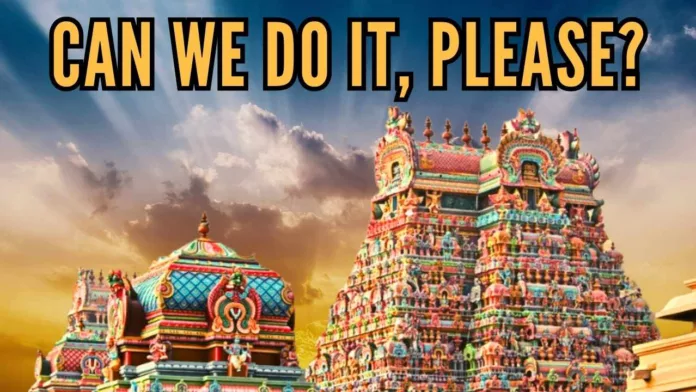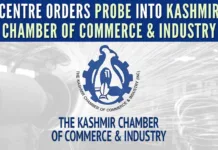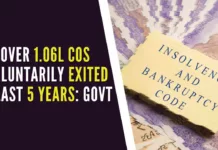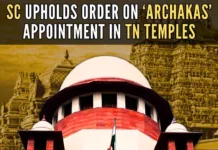
Introduction
This proposal is a humble attempt to find lasting solutions to a problem faced by various temples in Tamil Nadu (TN). Ancient temples that come under different Agamic traditions. For the sake of this proposal, I am taking them under one of the following categories:
- Shaiva or one of the two Sri Vaishnava Agamas
- Paadal Petra Sthalam (Hyms sung in praise of Bhagawan Siva by Nayanmars)
- Mangalasasanam by various Azhvars
- Abhimana Sthalam
- Visesha Sthala Puranam
All these temples are under government control through the Hindu Religious and
Charitable Endowments (HRCE) department. The government follows the categorization of temples based on the “income” each generates. This was used by the HRCE in a recent case in Madras HC, Madurai Bench. Sri Periya Nambi Narasimha Gopalan, Archaka at Rajagopalaswamy Kulasekara Azhvar Temple in Mannar Kovil went to court and got the direction to HRCE to pay minimum wages to the Archaka. HRCE went on appeal and obtained a stay on the order. The contention of HRCE which was accepted by the Honourable Court was that the Temple did not generate enough income to consider a raise in salary, which was Rs.200/ month for several years. Their argument was that the salary of the Archaka and service personnel cannot be paid from the income generated by other cash-rich temples and that each temple is an institution by itself.
Of the 46,000 odd temples under the control of HRCE, thousands of such Archakas languish with poor pay, non-support for Nithya Aradhana, crumbling infrastructure, and lack of footfalls due to lack of public connectivity.
In the last few years, I have been involved actively in identifying such temples and the Archakas who badly need support. X (Twitter) followers have been generous in ensuring a one-time Sambhavanai and or monthly support for a year for many such Archakas. However, there is something substantial to be done to find a solution to this vexing problem. Especially when the governments are inimical to the cause.
Glaring problem
I have noticed a glaring problem that needs to be addressed on a war footing. With the profession becoming non-remunerative, more importantly, hardly supporting the existence of a Dharmic family, there has been a migration of the younger generation of the Archakas to greener pastures. There are still some traditional Archakas who have steadfastly stood for Dharmic tradition and have trained their offspring to continue the hoary hereditary tradition. But this is gradually becoming an extinct species. There are many temples in remote areas, which are very ancient and are not frequented by the Asthikas, These temples are naturally “poor” temples under HRCE nomenclature. But they continue to be rich in divinity. Because of that single old Archaka in his 70s and 80s, who has not abandoned his duty to Dharma. I have just taken a list of 17 such temples and presented the list in the proposal. I can give hundreds, if not thousands at the appropriate time, should the proposal evince the interest of the government to whom it is addressed.
The moot question is what will happen to the temple after the Archaka attains the Holy feet of Sriman Narayana? Or attain Sivaloka Prapti?
This question has been troubling my mind for quite some time now. It set me thinking about how we can work together for a long-term solution. I don’t have the pretensions that this is the comprehensive solution to the problem. The basic structure can be enhanced, corrected, additions/ deletions made and perfected. I have just recorded my proposal. Fine-tuning is left to the government and more intelligent persons than me in society. The aim is to sensitize both the government and the society. Let the churning begin.
The Proposal
Let me divide the proposal into appropriate stages.
Stage-1: How to tackle the problem of diminishing numbers of Archakas in remote temples?
If we look at what the various State and Central governments did in terms of ensuring
the availability of qualified doctors in PHCs and rural areas, we get an idea. Several years ago, the State introduced a one-year mandatory rural posting, or “social responsibility service”, for all students after the completion of their MBBS course. During this one year, they are supposed to treat patients in Primary Health Centres (PHCs) or rural hospitals.
Proposed solution
- Apply this formula to the students of Vedas from various Veda Paatashalas.
- Make it mandatory for them to serve a rural temple for a period of 1 year after
completion of their Veda Adhyayana. - Pick such temples where there is a dearth of second in line for the existing old Archaka,
to be trained under him for a year. - Let that existing Archaka be on the selection committee panel, if any, to select a
candidate of his choice. - Give a generous Sambhavana (honorarium) of Rs.15,000/pm to the Vedica and
Rs.10,000/pm to the Master Archaka for his service of training the young Archaka. - If the young Archaka wishes to continue, he will be taken as a permanent Archaka under
a new scale of pay. If he doesn’t wish, a new young Archaka will be sent from the next
batch. - However, these Veda Paatashalas aren’t run by the government and are run by either
private or by different Mathams. Government should find a way to enlist these for the
proposed plan, like the law was made applicable to both government and private
colleges of MBBS.
Stage-2: How do we fund this?
I have thought of the possible ways to fund this. Learned people in the Ministry can apply their minds and come out of alternate ways, if any, to support.
- TTD: The Tirumala Sri Venkateshwara Mandir has an allied Trust by the name of Sri Vani Trust. The mission of the Trust is to renovate dilapidated temples and construct new temples. The Trustees should be convinced to include support to such Archakas and their masters from Stage 1, who have been assigned for service to such rural temples, in their Mission and the memorandum and articles of association of the Trust. Going by the number of Rs.10,500/- tickets it sells per day under Sri Vani Trust, a small portion of this to ensure regular pujas and a permanent solution to the problem of non-availability of Archakas in remote temples can be solved by this one single temple.
Let us look at the larger picture from where this can be funded. For this, we need the Ministry of Finance and Ministry of Culture to seriously give this issue a thought and take appropriate steps in the interest of the preservation of our culture and heritage. - Let us look at the Companies Act, 2013. A company covered under Section 135(1) of the Companies Act, 2013 is required to spend 2% of the average net profits of the company made during the three immediately preceding financial years towards Corporate Social Responsibility (CSR).
Section 135 of the Companies Act, 2013 makes it mandatory for the following companies
to comply with CSR provisions:
- Every company having a net worth of Rs.500 crores or more, or
- Every company having a turnover of Rs.1,000 crores or more, or
- Every company having a net profit of Rs.5 crores or more.
If we look at Permitted CSR Activities, two points can be made relevant to this purpose by the Ministry of Finance in consultation with the Ministry of Culture.
Point 2 states:
Promoting education, including special education, enhancing vocation skills, especially among children, women, elderly, and the differently abled, and livelihood enhancement projects.
My take:
- Education should include Vedic Education also. (Since it is simply stating education, should we conclude it includes Vedic education also?). The ambiguity should be cleared so Veda Paatashalas can immensely benefit from Corporate funding out of C.S.R.
- Currently, Vedic Education has itself become a kind of Special Education.
- Vedic Education enhances vocational skills, if the students are sent on a 1-year training to serve under a master as trainee Archaka in a remote temple, it serves to enhance their vocational skills to perform Kainkaryam to the presiding deity.
- This will enhance the livelihood of thousands of students after the completion of their course and protect our temples, culture, and heritage.
- This will also aid in the rejuvenation of such remote temples and lead the way to greater footfall, thus benefiting society at large.
Point 5 states:
Promotion of national heritage, art, and culture including restoration of buildings and sites of historical importance and works of art, setting up public libraries, promotion and development of traditional and handicrafts.
My Take:
- Any ancient temple is a National heritage, even if explicitly not declared so by the
government as a heritage structure or monument. - The Archaka Kainkaryam is an important part of this heritage. Archakatvam is part of the culture. This classification should not be denied to them. As they have been rendering the service for generations as a cultural practice, in many cases as hereditary Archakas and as part of the culture and heritage of the temple.
The Ministry of Finance and The Ministry of Culture should give this serious thought and should accept that those performing the Archaka and allied service Kainkaryam are a part of heritage and culture, hence any financial support to them by the corporates should be considered under the C.S.R.
The WICR-ICAI Reference Manual 2022-23 (I have taken Western India as a reference since most Corporates have their HQ in Western India) states in its well-articulated note that “The entries in the said Schedule VII must be “interpreted liberally” (emphasis added) so as to capture the essence of the subjects enumerated in the said schedule”
Point 4 under the essence of CSR, WICR-ICAI further states:
Salaries paid by the companies to regular CSR staff as well as to the volunteers of the companies (in proportion to companies’ time/ hours spent specifically for CSR) can be factored into CSR Project cost as part of the CSR expenditure.
My Take:
- The students trained in Veda Paatashalas and undergoing 1 year of training as Archaka in a remote temple can either be paid as a CSR temporary employee of the company or preferably a volunteer of the company under the CSR. Similarly, Master Archaka’s Sambhavana can be treated under CSR volunteer salary.
- Both such expenses should be allowed under CSR for tax relief for the company. All are ancient temples. Few are not under HRCE, yet, in remote villages with little connectivity and no regular footfalls.
Conclusion
I have identified the existing problem as I see it and its implication on the future, if it is not addressed. I have made two proposals that I see as long-term solutions to this problem. I deem it as important as the solutions would help save the heritage and culture of our Punya Bhoomi.
If more companies come forward to fund Veda Paatashalas and support Vedic students as trainee Archakas, the rejuvenation of such culture is immediately possible in a geometric proportion. That I have taken TN as the example is not intended in any way to demean the suffering of similar learned Archakas of other states. There are more competent and learned people than me in the rest of India, who can take this forward in terms of their respective states, with funding from corporates under CSR. It is my fervent appeal to the Ministry of Finance and Ministry of Culture kindly to consider a serious look into the proposal and proceed to save the heritage and culture of our Punya Bhoomi.
Note:
1. Text in Blue points to additional data on the topic.
2. The views expressed here are those of the author and do not necessarily represent or reflect the views of PGurus.
PGurus is now on Telegram. Click here to join our channel and stay updated with all the latest news and views
For all the latest updates, download PGurus App.
- Can we do it, please? - August 21, 2023
- Coaching Beyond – My days with Indian Cricket Team - June 28, 2023
- Who Killed SSR? – A book review (SSR-Sandeep Singh Rajput) - April 5, 2023











S V Badri – jewel on PGurus.